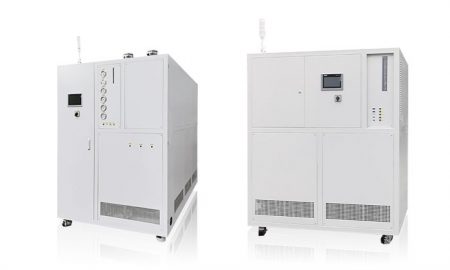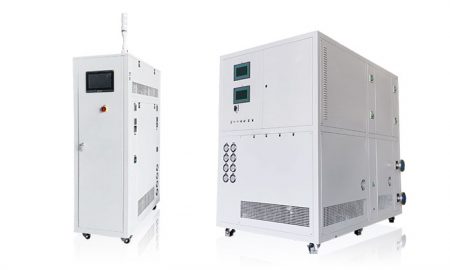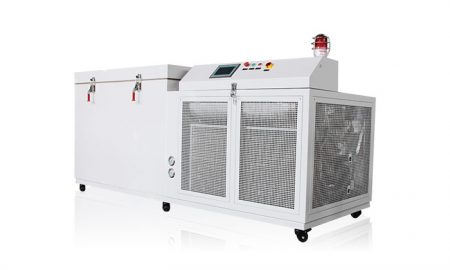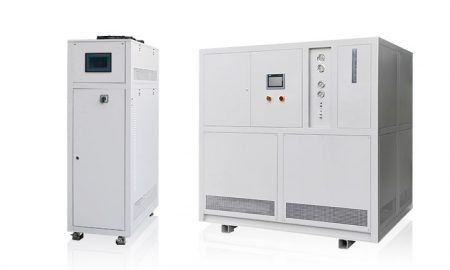Detailed Selection Formula of Chiller
1. Calculate the calorific value by the temperature difference between the cooling water (oil) inlet and outlet
Q = SH × De × F × DT / 60
Q: Calorific value KW
SH: Specific heat. The specific heat of water is 4.2KJ/Kg*C (4.2 kJ/kg*°C). The specific heat of oil is 1.97KJ/Kg*°C (1.97kJ/kg*°C).
De: density. The density of water is 1Kg/L (1 kg/L). The density of the oil is 0.88Kg/L (0.88kg/L).
F: Flow LPM (L/min).
DT: Cooling water (oil) inlet and outlet temperature difference (outlet temperature – inlet temperature).
Note: “/ 60” is used to convert flow liters/minute to liters/second; 1kW = 1kJ/s.
Example 1: The cooling water inlet is 15°C, the outlet water is 20°C, and the flow rate is 20 liters/min.
The calorific value Q = 4.2 × 1 × 20 × (20-15) / 60 = 7KW.
When choosing a chiller, the cooling capacity can be appropriately increased by 20%-50%, and CBE-03W can be selected.
Example 2: The cooling oil inlet is 18°C, the outlet oil is 26°C, and the flow rate is 15 liters/min.
The calorific value Q = 1.97× 0.88×15×(26-18) /60 = 2.6KW.
When choosing the cooling capacity of cold water (oil) machine, it can be appropriately increased by 20%-50% to choose CBE-02A.
2. Estimate the power and calorific value of the equipment.
a. If it is used for spindle cooling, the cooling capacity of the required refrigeration unit can be estimated according to 30% of the spindle motor power.
Example: 15KW motor, optional refrigeration unit with 4.5kw or 5.8kw cooling capacity.
b. The injection molding machine can be calculated according to the cooling capacity of 0.6KW per ounce or the cooling capacity of 3KW per 80 tons.
3. Calculate the calorific value by the temperature rise of the water (oil) tank.
Q = SH × De × V × DT / 60
Q: Calorific value KW
SH: Specific heat. The specific heat of water is 4.2KJ/Kg*C (4.2 kJ/kg*°C). The specific heat of oil is 1.97KJ/Kg*C (1.97kJ/kg*°C).
De: density. The density of water is 1Kg/L (1 kg/L), and the density of oil is 0.88Kg/L (0.88 kg/L).
V: Water volume L (liters) includes the total water volume in the tank and piping.
DT: Greater temperature rise of water (oil) in one minute.
Note: “/ 60” is used to convert temperature rise, °C/min into °C/sec; 1kW = 1kJ/s.
Note: When measuring, the temperature of the water (oil) tank needs to be slightly lower than the ambient temperature; and the equipment is working under a larger load.
Example: The water tank volume is 3000L and the water temperature is 0.6 degrees/min.
The calorific value Q = 4.2 × 1 × 3000 × 0.6 / 60 = 126KW.
When choosing the cooling capacity of the chiller, it can be appropriately increased by 20%~50% to choose CBE-50W.
Additional instructions:
1. The cooling capacity of the chiller varies with the ambient temperature and the outlet water temperature;
2. The actual calorific value of the equipment will also change due to different workpieces, molds, parameters, etc.;
3. After using the chiller, the temperature will drop, and the surface temperature of the connecting pipeline, water tank, fuel tank, mold, spindle, and equipment will be lower than the ambient temperature, so it will absorb heat and increase the load;
4. In the practical application of industrial cooling, many situations cannot be accurately calculated by the above methods. At this time, it can only be estimated by methods such as empirical data and analogy of similar equipment.
5. Any calculation method may have deviations, so that the actual selected refrigeration unit is too large or too small, so the above method is only for reference.
We are a professional manufacturer of temperature control equipment, supporting customized services, please consult us for details!
Temperature Control Range: -150°C to +50°C

Dynamic Temperature Control Systems
Temperature Control Range: -120°C to +350°C

Temperature Control Range: -40°C to +100°C

Temperature Control Range: -85°C to +250°C

Temperature Control Range: -150°C to -10°C
 LNEYA
LNEYA
 简体中文
简体中文


















































































